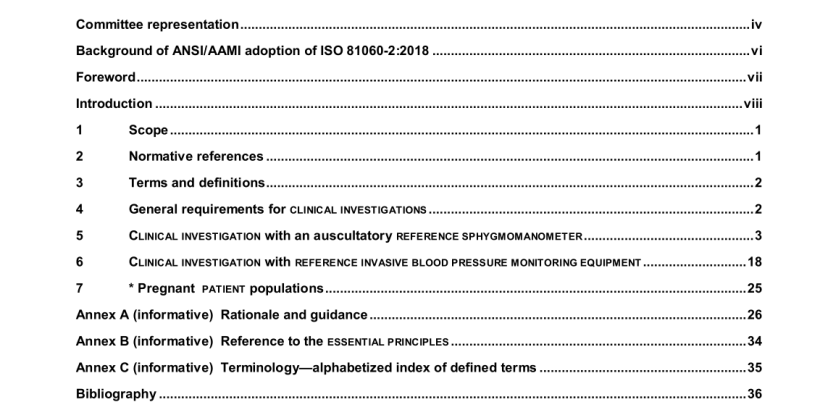ANSI AAMI ISO 81060-2-2019 pdf download
ANSI AAMI ISO 81060-2-2019 pdf download.Non-invasive sphygmomanometers
1 Scope
This document specifies the requirements and methods for the CLINICAL INVESTIGATION of ME EQUIPMENT used for the INTERMITTENT non-invasive automated estimation of the arterial BLOOD PRESSURE by utilizing a CUFF . This document is applicable to all SPHYGMOMANOMETERS that sense or display pulsations, flow or sounds for the estimation, display or recording of BLOOD PRESSURE . These SPHYGMOMANOMETERS need not have automatic CUFF inflation. This document covers SPHYGMOMANOMETERS intended for use in all PATIENT populations (e.g. all age and weight ranges), and all conditions of use (e.g. ambulatory BLOOD PRESSURE monitoring, stress testing BLOOD PRESSURE monitoring and BLOOD PRESSURE monitors for the HOME HEALTHCARE ENVIRONMENT for self-measurement as well as use in a professional healthcare facility). EXAMPLE A UTOMATED SPHYGMOMANOMETER as given in IEC 80601-2-30 undergoing CLINICAL INVESTIGATION according to this document. This document specifies additional disclosure requirements for the ACCOMPANYING DOCUMENTS of SPHYGMOMANOMETERS that have passed a CLINICAL INVESTIGATION according to this document. This document is not applicable to CLINICAL INVESTIGATIONS of NON – AUTOMATED SPHYGMOMANOMETERS as given in ISO 81060-1 or INVASIVE BLOOD PRESSURE MONITORING EQUIPMENT as given in IEC 60601-2-34.
5.1.3 * Age distribution
a) For a SPHYGMOMANOMETER intended for use on adults or adolescent PATIENTS , the age of every subject included in the CLINICAL INVESTIGATION shall be greater than 12 years.
NOTE 1 Minimum total of 85 subjects.
b) For a SPHYGMOMANOMETER additionally intended for use in children, 35 child subjects aged between 3 years and 12 years shall be included in the CLINICAL INVESTIGATION .
NOTE 2 Minimum total of 85 subjects (35 children aged 3-12 years and 50 subjects older than 12 years).
c) If the SPHYGMOMANOMETER has a special mode for children, in that mode, children shall be considered a special PATIENT population (see 5.1.6). In such a study, children are exempt from the BLOOD PRESSURE distribution requirements of 5.1.5.
d) Children aged less than 3 years shall not be included in a CLINICAL INVESTIGATION utilizing auscultatory REFERENCE readings by observers with a REFERENCE SPHYGMOMANOMETER
5.1.4 Limb size distribution
a) For a SPHYGMOMANOMETER intended for use with a single CUFF size:
1) at least 40 % of the subjects shall have a limb circumference which lies within the upper half of the specified range of use of the CUFF ;
2) at least 40 % of the subjects shall have a limb circumference within the lower half of the specified range of use of the CUFF ;
3) at least 20 % of the subjects shall have a limb circumference which lies within the upper quarter of the specified range of use of the CUFF ;
4) at least 20 % of the subjects shall have a limb circumference within the lower quarter of the specified range of use of the CUFF ; and
5) at least 10 % of the subjects shall have a limb circumference which lies within the upper octal of the specified range of use of the CUFF ; and
6) at least 10 % of the subjects shall have a limb circumference within the lower octal of the specified range of use of the CUFF.
5.2.5 * Additional requirements for a SPHYGMOMANOMETER intended for use in exercise stress testing environments
a) For a SPHYGMOMANOMETER intended for use in exercise stress testing, an additional CLINICAL INVESTIGATION shall be performed.
1) During this CLINICAL INVESTIGATION , the subjects shall be stressed by dynamic (aerobic) exercise on a bicycle ergometer so as to increase their heart rate to at least 30 % above their resting heart rate.
2) The resting heart rate shall be recorded.
3) The heart rate for each DETERMINATION shall be recorded.
4) Any arm used for the REFERENCE reading and DETERMINATION shall be supported.
5) The CUFF shall be at the level of the left ventricle during the REFERENCE reading and DETERMINATION of BLOOD PRESSURE .
b) Any one of the CLINICAL INVESTIGATION methods described in 5.2.4 may be used.
1) The CLINICAL INVESTIGATION shall consist of a minimum of 35 subjects.
2) A stress testing study shall be exempt from the requirements of 5.1.1, 5.1.3, 5.1.4 and 5.1.5.
3) At least 10 % of the subjects shall have a resting SYSTOLIC BLOOD PRESSURE ≥140 mmHg (18,66 kPa).
4) An exercise stress monitoring study need not be evaluated with acceptance criterion 2 of 5.2.4.1.2 or 5.2.4.2.2.
